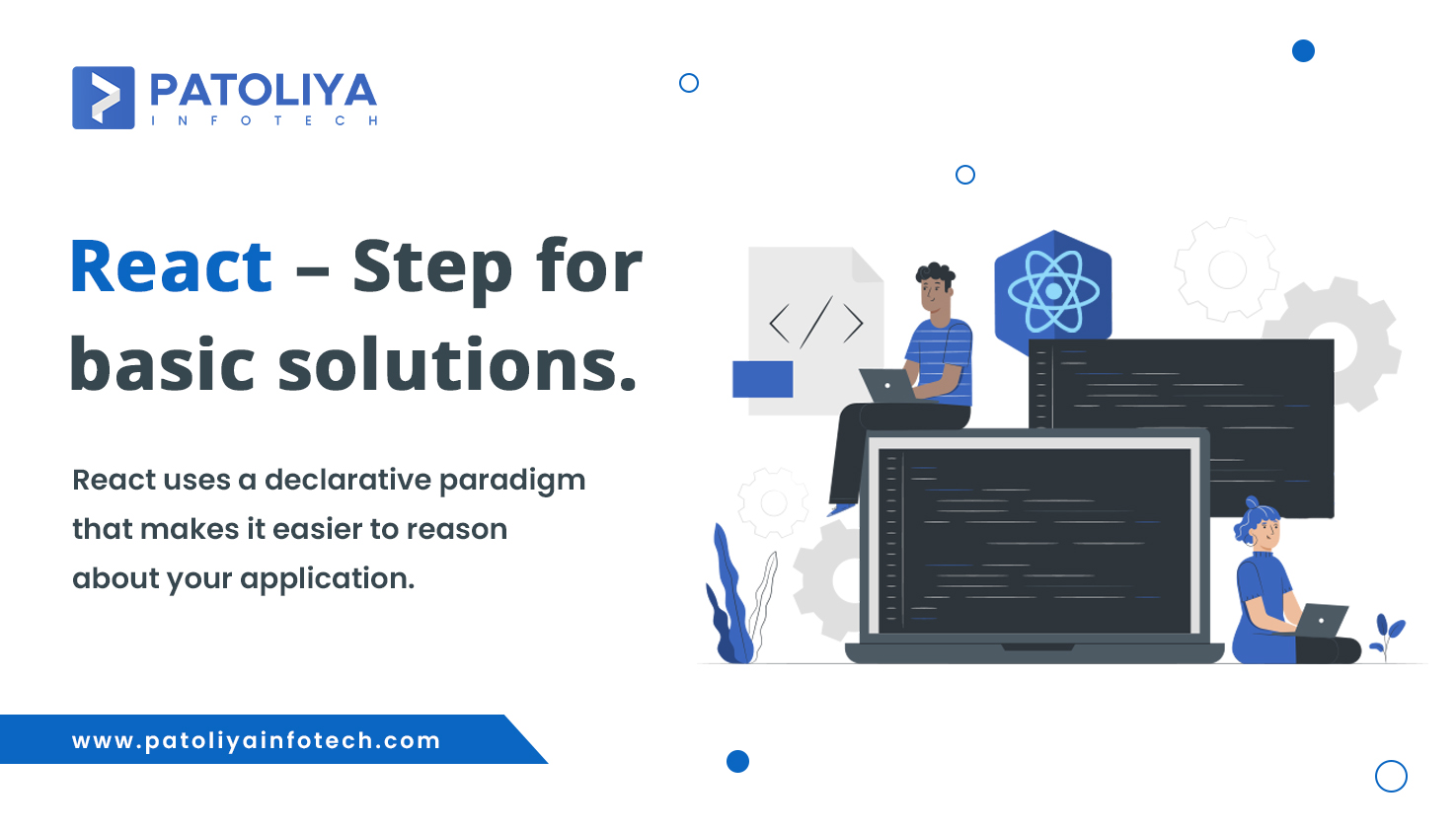React and Angular Frontend frameworks that compete for supremacy

Table of Contents
React is a JavaScript library for building user interfaces. It is maintained by Facebook and a community of individual developers and companies. React can be used as a base in the development of single-page or mobile applications, as it is optimal for fetching rapidly changing data that needs to be recorded.
AngularJS is a JavaScript-based open-source front-end web framework mainly maintained by Google and by a community of individuals and corporations to address many of the challenges encountered in developing single-page applications.
ReactJS is an open-source JavaScript library that is used for building user interfaces specifically for single-page applications. It’s used for handling the view layer for web and mobile apps. React also allows us to create reusable components.
React uses a declarative paradigm that makes it easier to reason about your application and aims to be both efficient and flexible. It designs simple views for each state in your application, and React will efficiently update and render just the right component when your data changes.
Dive deeper, in a nutshell!
Performance Comparison: React vs Angular
The following comparison provides an overview of the performance aspects of React and Angular based on common industry observations. It's essential to note that performance metrics can vary depending on specific project configurations, implementations, and optimization techniques used by developers.
Both React and Angular have bright futures ahead. They are constantly evolving and adapting to the changing landscape of web development. By staying updated on the latest trends and updates, developers can ensure they are using the right tools for the job and building applications for the future.
Ready to take your web development to the next level? Dive into the world of where Everything You Need to Know About NestJS.
Rendering and Virtual DOM:
React:
React's Virtual DOM mechanism optimizes rendering performance by creating a lightweight copy of the actual DOM. Upon any state changes, React efficiently identifies the differences between the virtual and real DOM, updating only the necessary components. This approach minimizes browser reflows and enhances rendering speed.
Angular:
Angular also uses a virtual DOM-like approach but operates through a different mechanism. Its change detection strategy tracks changes across the application and propagates updates throughout the view. However, Angular's change detection can become less efficient in complex applications with deeply nested components, potentially impacting performance.
DOM Manipulation:
React:
React employs a one-way data binding approach, ensuring predictable updates and reducing the likelihood of unintended side effects. This methodology results in better control over DOM updates and improves performance by minimizing unnecessary re-rendering of components.
Angular:
Angular utilizes two-way data binding by default, allowing automatic synchronization between the model and the view. While this feature simplifies development, it can impact performance, especially in larger applications, due to the frequent checks and updates across the entire data model.
Bundle Size and Load Time:
React:
React has a smaller footprint and modular structure, enabling developers to choose specific components as needed. This results in smaller bundle sizes and quicker initial load times, contributing to a more responsive user experience.
Angular:
Angular's framework comes with a larger footprint due to its comprehensive nature, encompassing various functionalities and features out-of-the-box. Consequently, the initial load time might be longer compared to React, especially for smaller applications where not all functionalities are required.
Learning Curve and Optimization:
React:
React's simplicity and focus on JavaScript and JSX make it relatively easier for developers to grasp. Its ecosystem provides numerous tools and libraries to optimize performance further, allowing developers to fine-tune applications according to specific needs.
Angular:
Angular's comprehensive nature and extensive functionalities might result in a steeper learning curve. However, Angular's built-in tools, such as Ahead-of-Time (AOT) compilation and tree shaking, aid in optimizing performance. Yet, maximizing these optimizations might require a deeper understanding of Angular's intricacies.
Community Support and Resources:
Community support plays a pivotal role in learning, troubleshooting, and advancing expertise in any framework or library. Both React and Angular boast active and vibrant communities, offering a plethora of resources for developers.
React:
React enjoys a massive community presence, contributing to its extensive array of resources. Online forums such as Stack Overflow, GitHub repositories, and dedicated React communities provide a wealth of knowledge. React's documentation is comprehensive, PHP for unmatchedregularly updated, and includes numerous tutorials, guides, and examples. The open-source nature of React encourages collaboration and the sharing of best practices among developers.
Angular:
Similarly, Angular benefits from a strong community backing, supported by Google and a vast network of developers. The official Angular documentation is thorough and constantly evolving, encompassing detailed guides, API references, and tutorials. Various online platforms like Stack Overflow, dedicated Angular forums, and GitHub repositories offer extensive support and a repository of solutions to common issues. Additionally, Angular's large community often contributes to numerous third-party libraries and tools, enriching the ecosystem.
Understanding the significance of community support and the availability of resources is crucial for developers seeking guidance, troubleshooting assistance, and staying updated with the latest practices in React and Angular.
This comparison aims to highlight the general trends in performance attributes and community support of React and Angular. It is advisable for developers to conduct their own performance evaluations and consider project-specific requirements when choosing between these frameworks.
Future Trends and Updates for React and Angular
Both React and Angular are dominant forces in the front-end development world, and keeping up with their future prospects is crucial for developers. Here's a glimpse into the exciting developments that might shape the future of each framework:
React:
- Concurrent Mode: This feature aims to improve responsiveness by allowing for concurrent rendering of updates. This will lead to smoother and more user-friendly applications.
- React Server Components: This upcoming feature allows developers to build components that render on the server, improving SEO and initial rendering performance.
- Focus on Performance: Expect further optimizations and improvements to the core framework, leading to even faster and more performant React applications.
- Integration with other libraries: React's ecosystem is vast and constantly evolving. Expect even tighter integration with popular libraries like GraphQL and Next.js.
- Growing adoption: React's popularity shows no signs of slowing down. Expect even more widespread adoption across various types of web applications.
Angular:
- Continued focus on Angular Ivy: This major update has significantly improved Angular's performance and developer experience. Expect further enhancements and improvements to Ivy.
- RxJS Integration: Angular has embraced RxJS for asynchronous operations, making it easier to manage data streams. This trend is expected to continue, making Angular even more powerful for complex applications.
- TypeScript: Angular's integration with TypeScript is growing stronger, making development more efficient and less prone to errors. This trend is likely to solidify TypeScript as the de facto language for Angular development.
- Web Components: Angular's support for Web Components is improving, allowing developers to create reusable and interoperable components. This can lead to more modular and maintainable applications.
- Progressive Web Apps (PWAs): Angular is well-suited for building PWAs, which are becoming increasingly popular. Expect further improvements and tools to make PWA development even more efficient.
E-commerce success awaits! Build with PHP for unmatched scalability, cost-effectiveness, and flexibility.
Trends that might influence usage:
- Hybrid and native development: Both React and Angular are exploring ways to build hybrid and native mobile applications. This could further increase their adoption and versatility.
- Headless CMS: The rise of headless CMS platforms is changing the way front-end applications are built. Both React and Angular are adapting to this trend and providing tools and integrations for working with headless CMS platforms.
- Accessibility: Accessibility is becoming increasingly important for web applications. Both React and Angular are making strides to ensure their frameworks are accessible to everyone.
- AI and Machine Learning: The integration of AI and Machine Learning into front-end development is opening up new possibilities. Both React and Angular are exploring ways to make it easier for developers to utilize AI and ML in their applications.



